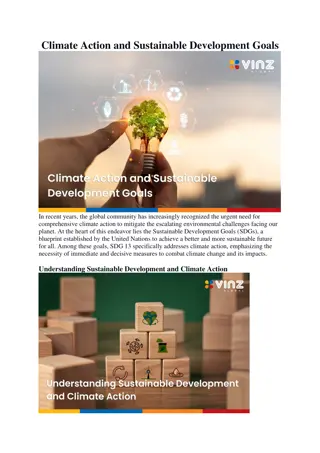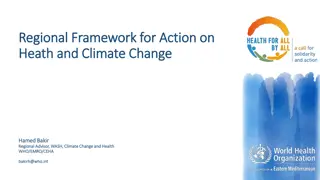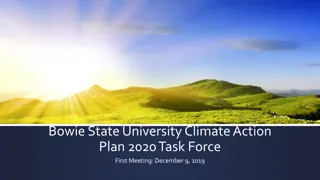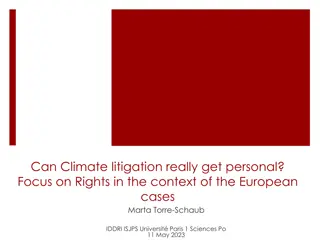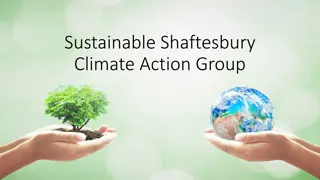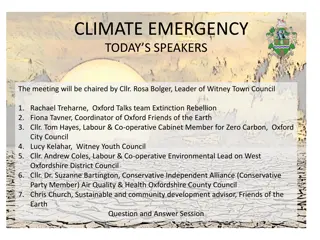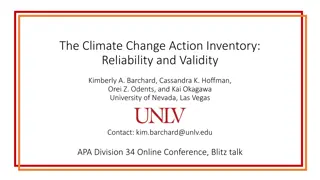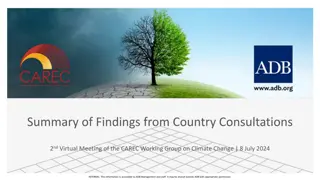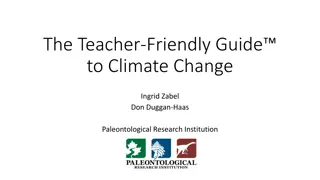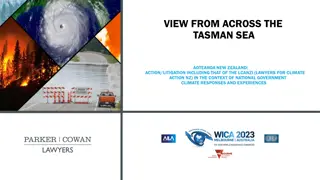Climate Action Plan
Join us in shaping Waterford's Climate Action Plan! Learn about reducing carbon emissions, adapting to extreme weather, and engaging with the public. Share your vision for a sustainable Waterford. Submit feedback by June 16. Let's work together for a greener future!
Download Presentation

Please find below an Image/Link to download the presentation.
The content on the website is provided AS IS for your information and personal use only. It may not be sold, licensed, or shared on other websites without obtaining consent from the author. Download presentation by click this link. If you encounter any issues during the download, it is possible that the publisher has removed the file from their server.
E N D
Presentation Transcript
Agenda Introduction - 5 minutes What are the council s responsibilities for Climate Action? Activity 10 minutes The Process 5 minutes Climate Adaptation, Transport, Agriculture and Household Emissions 15 minutes Break 5 minutes Waterford City, Land Use, Manufacturing, Industrial - 15 minutes What are other places doing? 5 minutes How we are engaging with the public 2 minutes
The Climate Action Plan A 5-year plan which will set out the actions the Council will take to reduce its own carbon footprint, the actions we will take to help citizens/businesses reduce their carbon emissions and how we will prepare for extreme weather (drought, flooding, storms). Currently at pre draft stage submissions being taken until June 16th https://consult.waterfordcouncil.ie/en/consultation/climate-action- plan-pre-draft-consultation
The goal of today 1. To introduce the challenge, the opportunities and the responsibility that the Council has 2. To ensure that all attendees have the information they need to speak with constituents on this topic 3. To understand how we fit into the bigger picture
The bigger picture Each Local Authority is creating a Climate Action Plan. Most European municipalities started this work years ago. Each Public Sector body will also look at their own impact and work to influence the public Teagasc, Department of Agriculture, Department of Health, OPW, Fisheries, Irish Water, Met Eireann, SEAI, IDA etc
Questions to Consider: What would you like the Council to do in this area? What personal actions would you like to take to contribute to climate action? What is your vision of Waterford in 2030 and beyond? What would you like to see?
Climate Adaptation Climate Adaptation taking action to prepare for and adjust to the current and future impacts of climate change. A common example is the construction of flood defences in flood prone areas. Waterford is a coastal county, placing it at a heightened risk of coastal flooding. Pluvial (when the ground is saturated) and fluvial/river flooding are also likely to increase with worsening climate change. Winter storms and strong winds are causing sand to migrate in coastal areas, impacting roads and nearby amenities. Higher temperatures during the summer months is likely to lead to acute temperature increases in urban areas, particularly where there are buildings that reflect/trap heat between them.
Climate Adaptation It is expected that many weather events will go from Common (occurs once in a 2-10 year period) to Frequent (occurs once in a 1-2 year period) with worsening climate change. The Council has influence over climate adaptation through flood defence schemes, parks and open space maintenance, transport route improvements, emergency planning and community engagement. The Council does not have influence over Climate Adaptation on private land.
Transport In line with climate action targets, Ireland's transport network is undergoing significant change. These changes include improvements in public transport routes, active travel and provision of EV charging infrastructure. The aim is to deliver at least 500,000 additional daily active travel and public transport journeys by 2030 and a 10% reduction in the number of kilometres driven by diesel and petrol cars. The National Sustainable Mobility Policy sets out a strategic framework to 2030 for active travel (walking and cycling) and public transport journeys to help Ireland meet its climate obligations. The Council has influence in this area through active travel planning, transitioning and managing its own fleet, road and parking management and collaboration with national transport bodies.
Transport The private car is the main mode of transportation in Waterford for both school drop offs and work commutes. There is little difference between the city and the county in this respect with 69% of people in the city commuting by car with 66% commuting by car in the county as a whole. Waterford is known for its innovation in the area of active travel as the first county in Ireland to put in place a Greenway. Through NTA funding, the Council Active Travel Team, Climate Action Team and public consultation, cycling and walking routes are being expanded and improved upon. The Waterford Metropolitan Area Transport Strategy was recently published. This Strategy sets the framework for an accessible, high-quality and integrated transport network that provides for the travel demand and supports the sustainable growth of the Waterford Metropolitan Area.
Residential Greenhouse Gas Emissions Relative to 2018, Ireland needs to reduce its emissions from electricity consumption by 62-81% and in relation to buildings by 44-56%. Residential heating in Waterford comes primarily from fossil fuels such as oil and gas. The Building Energy Rating (BER) of Waterford s housing stock lies on the lower end of the A-G scale, with most houses sitting in the C category for energy efficiency. A C-rated house will spend over 3 times as much on energy each year as an A-rated house. Through the provision of home energy upgrade grants via the SEAI, it is anticipated that the energy efficiency of homes in Waterford will improve. The Council will look to work with the SEAI to facilitate provision of information and grant application assistance.
Residential Greenhouse Gas Emissions The Council s own building stock also requires retrofitting to reach a 50% energy reduction by 2030. This is being carried out on an incremental basis. The ambition is to remove all fossil-fuelled boilers from Council buildings by 2025, in favour of heat pumps and other energy efficient alternatives. The Council social housing stock will require energy upgrades moving forward. This will ensure lower emissions, a greater degree of warmth for inhabitants along with cost savings and a lower risk of energy poverty occurring.
See what other places are doing Spin the wheel
Publicising the pre draft Schools PPN Libraries 3 events Chambers Social media Local authority staff email and intranet Deadline 16thJune Draft due in September











